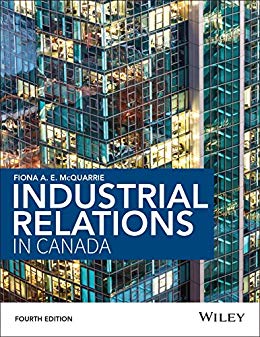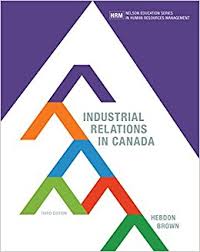Description
Test Bank For Industrial Relations in Canada 4th Edition By Fiona McQuarrie
Test Bank to Accompany McQuarrie/Industrial Relations in Canada, Fourth Edition
CHAPTER 2
THEORIES OF INDUSTRIAL RELATIONS
Multiple Choice Questions
1. Which of the following is an example of a craft guild in 17th-century North America?
- Weaving
- Tool making
- Carpentry
- All of the above
Answer A Page 30 easy
2. Call centre jobs are not characterized by the following
- Low paying
- Unrewarding
- Good pension plans
- Little job security
Answer C Page 28 intermediate
3. Which of the following was not a function served by craft guilds in North America?
- Supplying insurance
- Providing a replacement during the owner’s absence
- Education
- Financial planning
Answer D Page 30-31 intermediate
4. In the factories of the Industrial Revolution, control of the business rested with the factory owner. Which of these was not a function performed at the discretion of the owner?
- Designing the production process
- Designing a payment schedule in conformity with the guidelines established by the craft guild
- Deciding how the work was to be performed
- Deciding who would perform the work
Answer B Page 33 intermediate
5. A law was passed in Britain in 1819 that placed limits on child labour. These limits included which of the following?
- A prohibition against the hiring of children younger than nine
- A prohibition against older children working more than 10 hours per day
- A prohibition against adults working more than 12 hours per day
- All of the above
Answer A Page 34 intermediate
6. In what aspect of trade unions were the Fabian Society, founded by Sidney and Beatrice Webb, interested?
- The results of the prolonged exposer to unsafe working conditions
- advocacy on behalf of working children
- legal protection for injured adult workers
- how trade unions emerged in response to industrialized work structures
Answer D Page 34 intermmediate
7. According to the Webbs, what was the primary reason for the emergence of unions?
- The need to improve working conditions
- The separation between capital and labour
- Dissatisfaction with capitalism
- The increasing cost of living
Answer B Page 35 intermediate
8. In the factory-based economy, who provides the capital?
- The government
- Craft guilds
- Investor groups
- None of the above
Answer D Page 35 intermediate
9. According to the Webbs, what two internal devices did unions use to ensure that unions themselves were democratic and representative of their members’ interests?
- Device of mutual insurance and legal enactment
- Device of common rule and collective bargaining
- Device of the common rule and restriction of numbers
- Device of restriction of numbers and mutual insurance
Answer C Page 36 intermediate
10. Selig Perlman felt that unions should focus on creating economic security and opportunity to bring about what result?
- The promotion of large-scale social change.
- The creation of a stable, long-term basis for union existence.
- A rejection of the principles of capitalism.
- A greater practical understanding of union members by the middle class.
Answer B Page 37 difficult
11. Which two elements did John Commons believe would provide opportunities for unions and lead to the development of national and international unions?
- Publicity and improved communication
- Transportation and communications
- Competition in markets and geography
- Skilled workers and transportation
Answer B Page 37 intermediate
12. Which of the following is not a functional type of unionism identified by Robert Hoxie?
- Business unionism
- Friendly unionism
- Wartime unionism
- Predatory unionism
Answer C Page 38-39 easy
13. According to E. Wight Bakke, what is the worker’s main reason for joining a union?
- To counter the forces of capitalism
- To achieve a specific standard of living
- To improve their political power
- To encourage the development of socialism
Answer B Page 39 intermediate
14. When examining the system put forward by John Dunlop, we see that there are four contexts in which processes take place. Which of the following is not one of these contexts?
- Technological
- Market
- Budgetary
- Legislative
Answer D Page 42-43 intermediate
15. According to John Dunlop, the ‘web of rules’ does what within an organization?
- Avoids conflict
- Ensures order
- Governs the interactions between the parties
- Ensures compliance with labour legislation
Answer C Page 43 easy
16. Karl Marx and Freidrich Engels believed that the emergence of unions was a symptom of what?
- The need to overthrow capitalism
- An ongoing class struggle
- The need for political action
- The need to improve workers’ standard of living
Answer B Page 44 intermediate
17. According to Karl Marx and Freidrich Engels, what was the ultimate goal of unions?
- The overthrow of capitalism
- To become a vehicle of class discontent
- The development of a classless society
- All of the above
Answer D Page 45 intermediate
18. According to Harry Braverman, what is the term used to describe a situation where work is subdivided to such a degree that dependence on highly skilled labour is reduced or eliminated?
- Industrial engineering
- Scientific management
- Deskilling
- Statistical process control
Answer C Page 45 easy
19. Thomas Kochan, Robert McKersie, and Peter Cappelli believed that employers have become active rather than reactive participants in industrial relations. Which of the following is not a phenomenon in support of this assertion?
- Companies becoming part of employer associations
- Companies lobbying for legislation to reduce the power of unions
- The existence of strikebreaking firms
- Non-unionized companies harassing employees attempting to organize unions
Answer A Page 46-47 difficult
20. According to Richard Chaykowski and Anil Verma, why will Canadian unions resist cooperative relationships with management?
- Because they believe they will no longer be needed by workers
- Because it could weaken their ability to oppose unwanted change in the future
- Because it could weaken their ability to effect social and political change
- All of the above
Answer B Page 48 difficult
21. What is the percentage of the unionized workforce in Canada?
- 40
- 33
- 12
- 30
Answer D Page 28 easy
-
- The 14th century craft guilds were like unions in what regard?
- Provided employment protection to guild members
- Provided incentives to members to join
- Encouraged members to work on only one aspect of the final product
- Acted on behalf of the members with facility owners
Answer A Page 30 easy
-
- Success within the guild required all but the following attributes
- Good health
- Good support system
- Skill
- Good work ethic
Answer B Page 31 intermediate





Be the first to review “Test Bank For Industrial Relations in Canada 4th Edition By Fiona McQuarrie”